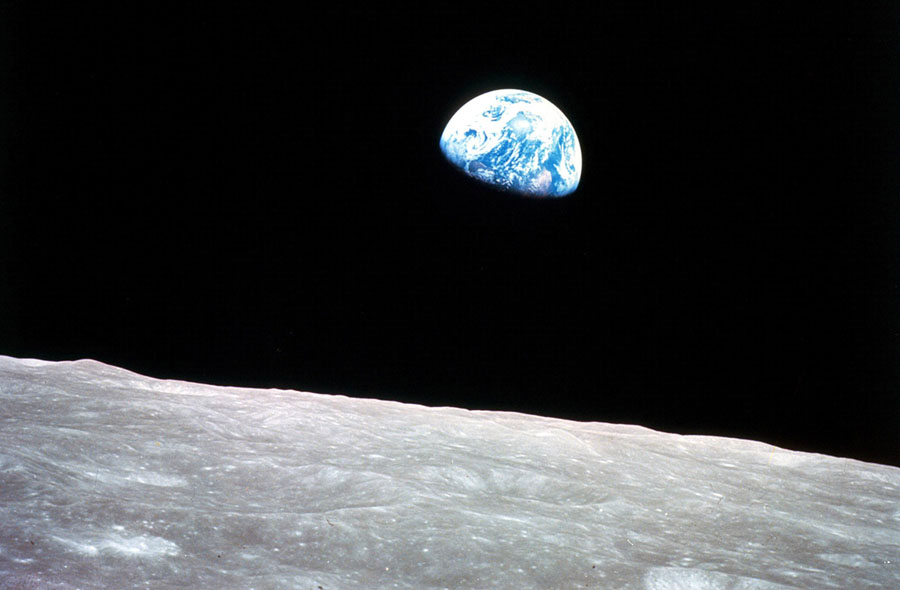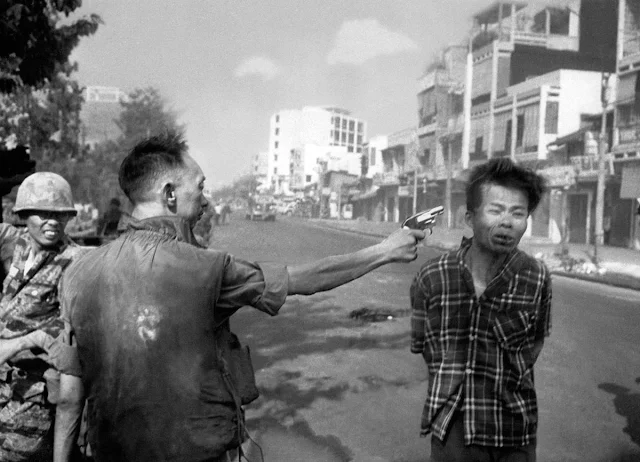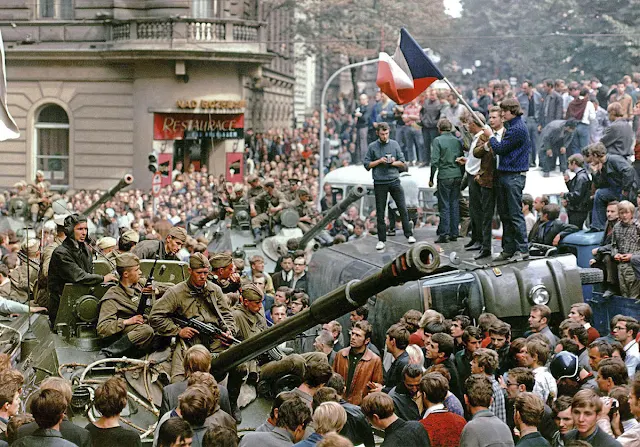(...Cont.)
ALAN TAYLOR JAN 10, 2018
https://www.theatlantic.com/photo/2018/01/50-years-ago-in-photos-a-look-back-at-1968/550208/
A half-century ago, much of the world appeared to be in a state of crisis. Protests erupted in France, Czechoslovakia. Germany, Mexico, Brazil, the United States, and many other places. Some of these protests ended peacefully; many were put down harshly. Two of the biggest catalysts for the protest were the U.S. involvement in the Vietnam War and the ongoing lack of civil rights in the U.S. and elsewhere. Two of America’s most prominent leaders, Dr Martin Luther King Jr. and Senator Robert F. Kennedy, were assassinated within months of each other. But some lessons were being learned and some progress was being made—this was also the year that NASA first sent astronauts around the moon and back, and the year President Lyndon Johnson signed the Civil Rights Act into law. It’s fitting that I post this retrospective today, since it is the day I was born—January 10, 1968. So, a 50th birthday present from me to you today: a look back at 1968.

United States President Lyndon B. Johnson listens to a tape recording from his son-in-law Captain Charles Robb at the White House on July 31, 1968. Robb was a U.S. Marine Corps company commander in Vietnam at the time. Robb was later awarded the Bronze Star and, after returning home, became governor of Virginia in 1982, and later a senator for the same state. Jack Kightlinger / AP
Original caption: Several hundred hippies gathered at "Hippie Hill" in San Francisco's Golden Gate Park for a happening at which several bands played rock 'n' roll music. Most of the hippies sat and listened, but some just couldn't keep from dancing to the rhythms. Bettmann / Getty
Mexican army soldiers crouch with weapons ready in Mexico City's Tlatelolco district, in this October 2, 1968 photo. The truth behind the stunning assault on a peaceful democracy protest known as the Tlatelolco Massacre, in which some 300 people are believed to have been killed, remains largely hidden by government and military secrecy. AP
Soldiers cut a student's hair after he was arrested during the first hour and a half of shooting in the Tlatelolco area in Mexico City on October 3, 1968. Another student stands against the wall. AP
SRI’s Bill English, the engineer who built the first computer mouse prototype, prepares for the December 9, 1968 "mother of all demos." The demonstration is hailed as one of the most significant technological presentations in history, showcasing technologies that have become what we now know as modern computing. He gave the first public demonstration of a computer mouse, a graphical user interface, windowed computing, hypertext, word processing, video processing, and much more. SRI International
Richard M. Nixon is mobbed by wildly cheering supporters as he arrives at the Hilton Plaza Hotel, his Miami Beach headquarters. Bettmann / CORBIS / Getty
French Foreign Minister Michel Debre and U.S. President Lyndon Johnson watch television coverage of the flight of the Saturn 1 B Rocket launching from Cape Kennedy, Florida, on on October 11, 1968, in the White House Office in Washington, D.C. Charles Gorry / AP
 A heavy beard covers the face of astronaut Walter M. Schirra Jr., Apollo 7 commander, as he looks out the rendezvous window in front of the commander's station on the ninth day of the Apollo 7 mission on October 20, 1968. Apollo 7 was the first Apollo mission to carry a crew, and it made 163 orbits around the Earth in 10 days, setting the stage for Apollo 8, which was heading to the moon. JSC / NASA
A heavy beard covers the face of astronaut Walter M. Schirra Jr., Apollo 7 commander, as he looks out the rendezvous window in front of the commander's station on the ninth day of the Apollo 7 mission on October 20, 1968. Apollo 7 was the first Apollo mission to carry a crew, and it made 163 orbits around the Earth in 10 days, setting the stage for Apollo 8, which was heading to the moon. JSC / NASA
 Apollo 8, the first manned mission to the moon, entered lunar orbit on Christmas Eve, December 24, 1968. That evening, the astronauts—Commander Frank Borman, Command Module Pilot Jim Lovell, and Lunar Module Pilot William Anders—held a live broadcast from lunar orbit, in which they showed pictures of the earth and moon as seen from their spacecraft. Said Lovell, "The vast loneliness is awe-inspiring and it makes you realize just what you have back there on Earth." They ended the broadcast with the crew taking turns reading from the book of Genesis. NASA
Apollo 8, the first manned mission to the moon, entered lunar orbit on Christmas Eve, December 24, 1968. That evening, the astronauts—Commander Frank Borman, Command Module Pilot Jim Lovell, and Lunar Module Pilot William Anders—held a live broadcast from lunar orbit, in which they showed pictures of the earth and moon as seen from their spacecraft. Said Lovell, "The vast loneliness is awe-inspiring and it makes you realize just what you have back there on Earth." They ended the broadcast with the crew taking turns reading from the book of Genesis. NASA
ALAN TAYLOR JAN 10, 2018
https://www.theatlantic.com/photo/2018/01/50-years-ago-in-photos-a-look-back-at-1968/550208/
A half-century ago, much of the world appeared to be in a state of crisis. Protests erupted in France, Czechoslovakia. Germany, Mexico, Brazil, the United States, and many other places. Some of these protests ended peacefully; many were put down harshly. Two of the biggest catalysts for the protest were the U.S. involvement in the Vietnam War and the ongoing lack of civil rights in the U.S. and elsewhere. Two of America’s most prominent leaders, Dr Martin Luther King Jr. and Senator Robert F. Kennedy, were assassinated within months of each other. But some lessons were being learned and some progress was being made—this was also the year that NASA first sent astronauts around the moon and back, and the year President Lyndon Johnson signed the Civil Rights Act into law. It’s fitting that I post this retrospective today, since it is the day I was born—January 10, 1968. So, a 50th birthday present from me to you today: a look back at 1968.
A U.S. Marine keeps his head low as he drags a wounded buddy from the ruins of the Citadel's outer wall during the Battle of Hue in Vietnam on February 16, 1968. Bettmann / Getty
United States President Lyndon B. Johnson listens to a tape recording from his son-in-law Captain Charles Robb at the White House on July 31, 1968. Robb was a U.S. Marine Corps company commander in Vietnam at the time. Robb was later awarded the Bronze Star and, after returning home, became governor of Virginia in 1982, and later a senator for the same state. Jack Kightlinger / AP
Original caption: Several hundred hippies gathered at "Hippie Hill" in San Francisco's Golden Gate Park for a happening at which several bands played rock 'n' roll music. Most of the hippies sat and listened, but some just couldn't keep from dancing to the rhythms. Bettmann / Getty
Mexican army soldiers crouch with weapons ready in Mexico City's Tlatelolco district, in this October 2, 1968 photo. The truth behind the stunning assault on a peaceful democracy protest known as the Tlatelolco Massacre, in which some 300 people are believed to have been killed, remains largely hidden by government and military secrecy. AP
Soldiers cut a student's hair after he was arrested during the first hour and a half of shooting in the Tlatelolco area in Mexico City on October 3, 1968. Another student stands against the wall. AP
SRI’s Bill English, the engineer who built the first computer mouse prototype, prepares for the December 9, 1968 "mother of all demos." The demonstration is hailed as one of the most significant technological presentations in history, showcasing technologies that have become what we now know as modern computing. He gave the first public demonstration of a computer mouse, a graphical user interface, windowed computing, hypertext, word processing, video processing, and much more. SRI International
Richard M. Nixon is mobbed by wildly cheering supporters as he arrives at the Hilton Plaza Hotel, his Miami Beach headquarters. Bettmann / CORBIS / Getty
French Foreign Minister Michel Debre and U.S. President Lyndon Johnson watch television coverage of the flight of the Saturn 1 B Rocket launching from Cape Kennedy, Florida, on on October 11, 1968, in the White House Office in Washington, D.C. Charles Gorry / AP


Get a copy of the book 'Real Lessons in Reel Life' here...Your entry into the elusive world of Maya, the stage set by Man to learn from to live on the stage set by Nature. https://asok22.wixsite.com/real-lesson





























